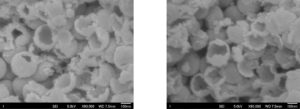Cavitation-inducing agents for sonochemistry

Applications: Wastewater treatment, catalytic oxidation, controlled radical polymerization, sonodynamic therapies
Ultrasound-mediated catalysis (sonocatalysis) generates localised intense temperatures and pressures through cavitation, which accelerates catalytic chemical reactions under bulk ambient conditions. Although considered a green process, current methods use long ultrasound exposure times and high acoustic energies. Exogenous gas nuclei are often added to reduce the energy required, however spatial decoupling between cavitation events and catalysts remains and lowers reaction efficiency.
| Features | Benefits |
|
|
|
|
|
|
|
|
Patent pending:
- Licensing
- Co-development
- Consulting
about this technology
© Oxford University Innovation

